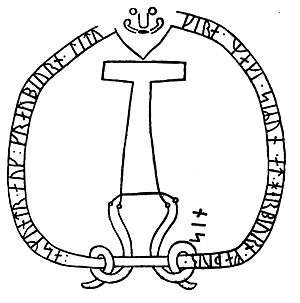Södermanland Runic Inscription 86
Sö 86 is the Rundata catalog number for a Viking Age memorial runic inscription located in Åby, which is about one kilometer north of Ålberga, Södermanland County, Sweden, and in the historic province of Södermanland. The inscription features a depiction of the hammer of the Norse pagan god Thor named Mjöllnir and a facial mask.

Description
This inscription has runic text in the younger futhark within a band that circles an image of Thor's hammer which is supported by two serpents. The inscription is carved on an outcropping of granite and the image is approximately 1.8 meters in height. Above the hammer is a facial mask of a man with a moustache and beard. The face represented by the mask is typically interpreted as being that of Thor due to its proximity to the hammer, although there are some who have suggested that the image represents the face of Christ above a cross.[2] A mask was a motif common on inscriptions and is found on several other surviving runestones in Scandinavia including DR 62 in Sjelle, DR 66 in Århus, DR 81 in Skern, DR 258 in Bösarp, the now-lost DR 286 in Hunnestad, DR 314 in Lund, DR 335 in Västra Strö, Vg 106 in Lassegården, Sö 112 in Kolunda, Sö 167 in Landshammar, Sö 367 in Släbro, Nä 34 in Nasta, U 508 in Gillberga, U 670 in Rölunda, U 678 in Skokloster, U 824 in Holms, U 1034 in Tensta, and U 1150 in Björklinge, and on the Sjellebro Stone.[3] The Sö 86 inscription is numbered among several in Scandinavia that have a dedication to Thor. The image of Thor's hammer was used on several other memorial runestones in Sweden and Denmark, perhaps as a parallel to or a pagan reaction to the use of the cross by Christians.[4] Other surviving runestones depicting Thor's hammer include runestones U 1161 in Altuna, Sö 111 in Stenkvista, Sö 140 in Jursta, Vg 113 in Lärkegapet, Öl 1 in Karlevi, DR 26 in Laeborg, DR 48 in Hanning, DR 120 in Spentrup, and DR 331 in Gårdstånga.[5][6]
The runic text indicates that Ásmundr and Freybjôrn raised the stone as a memorial their father Herbjôrn. Of the personal names mentioned in the text, Freybjôrn contains the Norse god Freyr as a theophoric name element and means "Freyr Bear."[7] The name Ásmundr means "Devine Hand"[7] and has a first element that refers to the Æsir, the name of the principal group of Norse gods. The names in the text also reflect a common practice of that time in Scandinavia of repeating an element in a parent's name in the names of the children.[8] Here the bjôrn from the father's name, Herbjôrn, is repeated in the name one of the sons, Freybjôrn, to show the family relationship.
Inscription
Transliteration of the runes into Latin characters
- : asmuhtr : auk : fraybiurn * litu kera : meki * siʀun * at * herbiurn * faþur : sin :[9]
Transcription into Old Norse
- Ásmundr ok Freybjôrn létu gera merki sírún/sírýn at Herbjôrn, fôður sinn.[9]
Translation in English
- Ásmundr and Freybjôrn had the rune-decorated landmark made in memory of Herbjôrn, their father.[9]
References
- Stephens, George (1878). Thunor the Thunderer, Carved on a Scandinavian Font About the Year 1000. London: Williams and Norgate. p. 33.
- Sundvist, Olof; Zachrisson, Torun (2004). "Recensioner" (PDF). Fornvännen. Swedish National Heritage Board. 99: 144–45. ISSN 1404-9430. Retrieved 04-05-2010. Check date values in:
|accessdate=(help) - Bertelsen, Lise Gjedssø (2006). "On Öphir's Pictures". In Stoklund, Marie; Nielsen, Michael Lerche; et al. (eds.). Runes and Their Secrets: Studies in Runology, Volume 2000. Copenhagen: Museum Tusculanum Press. pp. 46–47. ISBN 87-635-0428-6.
- DuBois, Thomas Andrew (1999). Nordic Religions in the Viking Age. University of Pennsylvania Press. pp. 158–159. ISBN 0-8122-3511-8.
- Holtgård, Anders (1998). "Runeninschriften und Runendenkmäler als Quellen der Religionsgeschichte". In Düwel, Klaus; Nowak, Sean (eds.). Runeninschriften als Quellen Interdisziplinärer Forschung: Abhandlungen des Vierten Internationalen Symposiums über Runen und Runeninschriften in Göttingen vom 4–9 August 1995. Berlin: Walter de Gruyter. p. 727. ISBN 3-11-015455-2.
- McKinnell, John; Simek, Rudolf; Düwel, Klaus (2004). "Gods and Mythological Beings in the Younger Futhark". Runes, Magic and Religion: A Sourcebook (PDF). Vienna: Fassbaender. pp. 116–133. ISBN 3-900538-81-6.
- Yonge, Charlotte Mary (2004). History of Christian Names. Kessinger Publishing. pp. xxxv, xxxix. ISBN 978-0-7661-8321-6.
- Peterson, Lena (2002). "Developments of Personal Names from Ancient Nordic to Old Nordic". In Bandle, Oskar; Elmevik, Lennart; et al. (eds.). The Nordic Languages: An International Handbook of the History of the North Germanic Languages. 1. Walter de Gruyter. pp. 745–753. ISBN 3-11-014876-5. p. 750.
- Project Samnordisk Runtextdatabas Svensk - Rundata entry for Sö 86.
External links
- Photograph of Åby inscription
- Maskesten - Billedsten fra Vikingtiden - Arild Hauge webpage on mask stones